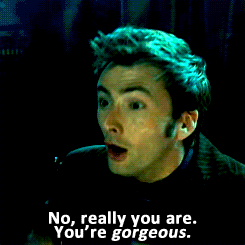So, now, onto today's post topic: puberty and the hormones that cause it.
Hormones are, at their most basic level, chemical signals from one part of your body that tell another part of your body to do something. Organs, glands, and even individual cells can produce hormones, and these hormones can have any effect from changing your metabolism to signalling fight-or-flight response to causing mood swings. They're the little buggers responsible for PMS (and the menstrual cycle in general), growth spurts, and of course puberty.
Puberty is a progression of physical changes in which a child's body matures into an adult body, capable of reproduction. Most girls hit puberty between ages 10 and 12, and finish it between 15 and 17. Within this window, a girl will start menstruating and develop breasts and pubic hair, as well as experience growth spurts and the hardening of the long bones (like the femur in your thigh).
The onset of puberty is signaled by an increased production of a hormone called gonadotropin-releasing hormone (GnRH), which is responsible for the release of follicle-stimulating hormone (FSH) and luteinizing hormone (LH) from the pituitary gland.
Basically, a part of your brain called the hypothalamus releases a hormone (GnRH) that tells your pituitary gland to make other hormones (FSH and LH). These two hormones zip straight to your ovaries and tell them to get started producing estrogen and progesterone. A specific form of estrogen called estradiol is the dominant hormone in female puberty, and it promotes the growth of the breasts and utuerus. FSH also tells your ovaries to kick it into gear, causing the maturation of the little follicles inside that will eventually release ovum during ovulation.
The first sign that puberty has started is breast development, which starts around 10.5 years old on average. A hard, tender lump will develop right under the areola and over the next 1.5-2 years will slowly approach their mature size and shape; that starter lump will generally fade back into the rest of the breast tissue at the end of this development. The areola will also grow in size and darken in color, and the nipple - which is typically an "innie" in children - will change to an "outie."
Another early sign of puberty is the development of pubic hair, which occurs right around the same time, or sometimes even slightly before, the breasts start to grow. The first pubic hairs usually grow on the labia and then spread up and over the mons pubis, eventually forming the "pubic triangle," and often grows on the top of the inner thighs and close to the abdomen as well.
Next, your lady bits start changing. The walls of your vagina will go from a bright red to a duller pink, and will also thicken a bit. Vaginal secretions will change in order to maintain the pH balance - which keeps all the naturally occurring microbes there happy and healthy and fighting infections. The labia majora and minora will also grow and change in color; the clitoris will grow as well. Shortly after breast development begins, the uterus, ovaries, and ovary follicles increase in size as they prepare to start menstruation. They reach full functioning size in about 2 years, which is when a girl will typically experience menarchy - that is, her first period... which is fun.
What, wasn't everyone's like this? No? Okay then...
Anywhere between ages 8 and 16 is normal for a girl to start her period, and the length of the menstrual cycle will be unpredictable for the first few years. Just because you start having your period doesn't necessarily mean you're ovulating - 80% of girls don't actually ovulate for the first year of cycles, 50% for the first three years, and 10% for the first 6 years. The full nitty-gritty details of menstruation will be covered in the next post (June 7).
Another delightful change in puberty is the shift in body proportion and body fat distribution. Rising levels of estrogen cause the shape of the pelvic bone to change, widening the hips (which makes a wider birth canal). Fat tissue rises to a higher percentage than that of males (about 6% more), popping up in the breasts, thighs, hips, butt, pubic mound, and upper arms. This higher level of fat is essential for maintaining and regulating the amounts of hormones needed for the menstrual cycle, which is why girls with low body fat and low weight tend to have more irregular periods. Those same hormones that regulate the mentsrual cycle are also necessary for bone development, which is why irregular periods correlate highly with osteoporosis (weak and brittle bones).
Self-disclosure time: I'm in recovery from anorexia nervosa. From age 16 to about 23, I was deeply engrossed in my eating disorder and greatly underweight. Even on birth control, I had extremely irregular periods, often going 6 months or more without one. Because of this, I have osteoporosis and osteopenia (which is basically pre-osteoporisis) despite being only in my late 20s. I've been in recovery for about 4 years now, at a healthy weight and with regular periods (still on birth control) and my bone health is slowly improving, but the damage I did to myself is very real. Not just to my bones, but to my heart, reproductive system, and other vital organs, which all suffered due to prolonged malnutrition. I guess what I'm trying to say with this is... be good to yourselves, ladies.
Okay, where was I? Right. The many wonderful changes caused by puberty.
All those hormones running through your body will also change the composition of your sweat, which can make it smell different... which is why oh so many teenagers really can benefit from proper use of soap and deodorant. These hormones can also cause your skin to produce more oil, leading to zits and full-on acne. For some of us, these zits and BO will mostly go away as puberty ends, but many times some degree of body odor and break-out will continue into adulthood. Thanks, hormones. Really, you shouldn't have.
Tune in in two weeks for a roadmap of menstruation.ho





